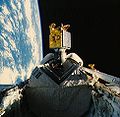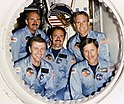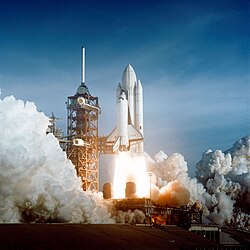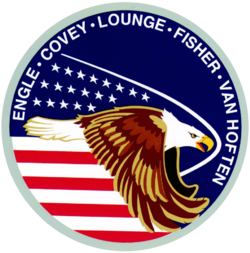STS-51-I
| Missionsemblem | |||
|---|---|---|---|
 | |||
| Missionsdaten | |||
| Mission | STS-51-I | ||
| NSSDCA ID | 1985-076A | ||
| Besatzung | 5 | ||
| Start | 27. August 1985, 10:58:01 UTC | ||
| Startplatz | Kennedy Space Center, LC-39A | ||
| Anzahl EVA | 2 | ||
| Landung | 3. September 1985, 13:15:43 UTC | ||
| Landeplatz | Edwards Air Force Base, Bahn 23 | ||
| Flugdauer | 7d 2h 17m 42s | ||
| Erdumkreisungen | 112 | ||
| Bahnhöhe | 389 km | ||
| Bahnneigung | 28,45° | ||
| Zurückgelegte Strecke | 4,6 Mio. km | ||
| Nutzlast | ASC-1, AUSSAT-1 und LEASAT-4 | ||
| Mannschaftsfoto | |||
 v. l. n. r. Vorne: Joe Engle, Richard Covey; Mitte: John Lounge; Hinten: James van Hoften, William Fisher | |||
| ◄ Vorher / nachher ► | |||
| |||
STS-51-I (englisch Space Transportation System) ist eine Missionsbezeichnung für das US-amerikanische Space Shuttle Discovery (OV-103) der NASA. Der Start erfolgte am 27. August 1985. Es war die 20. Space-Shuttle-Mission und der sechste Flug der Raumfähre Discovery.
Mannschaft
- Joe Engle (2. Raumflug), Kommandant
- Richard Covey (1. Raumflug), Pilot
- James van Hoften (2. Raumflug), Missionsspezialist
- John Lounge (1. Raumflug), Missionsspezialist
- William Fisher (1. Raumflug), Missionsspezialist
Missionsüberblick
Zwei Startversuche für diese Mission mussten abgebrochen werden. Am 24. August fiel der Entscheid aufgrund der Witterungsbedingungen bei T-5 Minuten, am 25. August zwang der Ausfall des Bordcomputers Nr. 5 zum Abbruch. Schließlich startete Discovery am 27. August, nachdem ein Schiff im gesperrten Seegebiet vor Florida nochmals für drei Minuten Verspätung gesorgt hatte.
Das Ziel der Mission war es, die drei Kommunikationssatelliten ASC-1, AUSSAT-1 und LEASAT-4 in die Umlaufbahn zu bringen sowie den mit der Mission STS-51-D ausgesetzten defekten Satelliten LEASAT-3 einzufangen, zu reparieren und wieder auszusetzen. Wegen eines Manipulationsproblems musste AUSSAT-1 bereits einen Tag früher als geplant ausgesetzt werden. Aus diesem Grund wurde die Mission um einen Tag gekürzt. LEASAT-4 wurde planmäßig in seine Umlaufbahn gebracht, konnte dort aber später nicht in Betrieb genommen werden, da eine der UHF-Sendeantennen defekt war. Die Reparatur an LEASAT-3 verlief erfolgreich, dazu waren Außenbordarbeiten von Fisher und van Hoften von insgesamt elf Stunden und 27 Minuten Dauer notwendig.
Die Landung erfolgte planmäßig in Edwards Air Force Base in Kalifornien. Discovery wurde fünf Tage später mittels eines Spezialflugzeuges nach Cape Canaveral, Florida zurücktransportiert.
Galerie
Aussetzen von AUSSAT-1
Aussetzen von ASC-1
Aussetzen von LEASAT-34
Der Astronaut Van Hoften arbeitet an LEASAT-3
Siehe auch
- Liste der bemannten Raumflüge
- Liste der Raumfahrer
- Liste der Space-Shuttle-Missionen
- Bemannte Raumfahrt
Weblinks
- STS-51-I in der Encyclopedia Astronautica (englisch)
- NASA-Missionsüberblick (englisch)
- Videozusammenfassung mit Kommentaren der Besatzung (englisch)
Auf dieser Seite verwendete Medien
View of the ASC-1 satellite after deployment on STS-51-I.
The American Satellite Company (ASC) communications satellite is deployed from the payload bay of the Shuttle Discovery. A portion of the cloudy surface of the earth can be seen to the left of the frame.
View of the AUSSAT-1 satellite after deployment on STS-51-I.
Australia's AUSSAT communications satellite is deployed from the payload bay of the Shuttle Discovery. A portion of the cloudy surface of the earth can be seen to the left of the frame.
The crew assigned to the STS-51I mission included (front row left to right) Joe H. Engle, commander; and Richard O. Covey, pilot. In the center is John M. (Mike) Lounge, mission specialist. On the back row, from left to right, are mission specialists James D. van Hoften, and William F. Fisher. Launched aboard the Space Shuttle Discovery on August 27, 1985 at 6:58:01 am (EDT), the STS-51I mission's primary payloads were three communication satellites: the ASC-1 for the American Satellite Company; the AUSSAT-1, an Australian communications satellite; and the SYNCOM-IV-4, the synchronous communications satellite.
The April 12 launch at Pad 39A of STS-1, just seconds past 7 a.m., carries astronauts John Young and Robert Crippen into an Earth orbital mission scheduled to last for 54 hours, ending with unpowered landing at Edwards Air Force Base in California.
View of the Syncom IV-4 satellite after deployment on STS-51-I.
The Syncom IV-4 communications satellite is deployed from the payload bay of the Shuttle Discovery in a frisbee fashion. A portion of the cloudy surface of the earth can be seen to the left of the frame.
Astronaut James van Hoften works on the Syncom IV-3 satellite on STS-51-I.
Astronaut James D. van Hoften gives a shove to the previously troubled Syncom IV-3 communications satellite. Dr. van Hoften stands on a foot restraint/extension to the remote manipulator system (RMS) arm.











